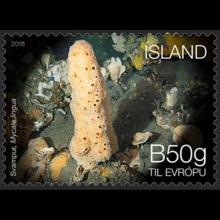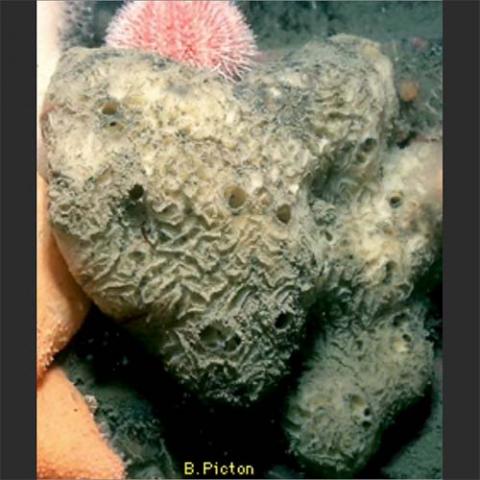NAMES
TAXONOMY
Iceland
Issued:
Stamp:
Mycale lingua
Iceland
Issued:
Stamp:
Mycale lingua
Iceland
Issued:
Stamp:
Mycale lingua
Genus species (Animalia): Mycale lingua
Mycale lingua (Bowerbank, 1866) is a greyish yellowish mass of lobes, often erect with a narrow base. The characteristic feature of this sponge is its furrowed surface; even after preservation, these grooves are still recognizable. It is an essentially deep water species, that comes into SCUBA depths (30 m) only at a few localities. It has a wide distribution over the Atlantic coasts of Europe.
Color
Grey, pale buff; in alcohol pale yellow, whitish yellow or gray.
Shape, size, surface and consistency
Encrusting to massive lobose to massive fig-shaped. Variously described as being "roundish", "resembling the tongue of a sheep", or "an inverted triangular pyramid''. It is apparent that some specimens tend to grow in an erect, flattened form, with the attached base narrower than the apex. Grows up to 30 cms in height, with variable width and depth. Surface sulcate, the furrows forming an irregular reticulation over the surface. Within the furrows, the dermal membrane is smooth, elsewhere it is rather shaggy in appearance. Oscules are borne on shallow, transparent cones of height 2-3 mm, and have a diameter of 4-10 mm. The inhalent pores lie along the surface of the furrows, and can only be seen with the aid of a microscope in preserved material but are obvious in living specimens. The sulcate cracks close on collection. Consistency rather tough, very fibrous, but easily compressed.
Spicules Mycale (lingua spics)
Megascleres are styles, usually straight, occasionally slightly curved: 460-1150 x 13-20 µm. Their ends are variable in shape. The head may be that of a typical style, or may tend to be that of a subtylostyle, or may be constricted like a handle ("mycalostyles"). The points may be abrupt or long. Microscleres are palmate anisochelae, sigmata and trichodragmas. The anisochelae fall into two distinct size classes: ca. 35 µm and 70 µm, the larger ones being found in rosettes, mainly near the dermal membrane; sigmata: ca. 16-32 µm; trichodragmas: 42-78 µm x 11-14 µm.
Skeleton
Ectosomal skeleton a mass of tangential spicules. Choanosomal skeleton plumoreticulate, consisting of ascending multispicular fibres of styles, with small amounts of spongin binding the fibres. Towards the surlace, some fibres run parallel to the surface, and some become splayed like a brush and penetrate the surface.
Ecology
Deeper water: found at depths between 30 and 2460 m. At depths accessible by SCUBA, the distribution is probably localised into discrete areas.
Distribution
Widely distributed over the north Atlantic, from the Azores to Spitzbergen. Also known from the Mediterranean. Recorded recently from Ushant and Ile de Vierge, Bretagne; Rathlin Island (N Ireland); Loch Sunart, Insh Island, and Bach Island, Firth of Lorne (Scotland); Faeroes.
Etymology
lingua (Latin) = tongue, referring to the shape.
Type specimen information
The type is in the Natural History Museum, London: BMNH 1930.7.3.235 (dry; as Raphiodesma). MCS voucher BELUM Mc1345. Brittany, France.
Remarks
The furrowed grooves on the surface of the sponge are highly characteristic.
Family: Mycalidae
Mycalidae is a family of marine demosponges which are the most diverse class in the phylum Porifera. They include 76.2% of all species of sponges with nearly 8,800 species worldwide (World Porifera Database). They are sponges with a soft body that covers a hard, often massive skeleton made of calcium carbonate, either aragonite or calcite. They are predominantly leuconoid in structure. Their "skeletons" are made of spicules consisting of fibers of the protein spongin, the mineral silica, or both. Where spicules of silica are present, they have a different shape from those in the otherwise similar glass sponges. Some species, in particular from the Antarctic, obtain the silica for spicule building from the ingestion of siliceous diatoms.
The many diverse orders in this class include all of the large sponges. Most are marine dwellers, but one order (Spongillida) live in freshwater environments. Some species are brightly colored, with great variety in body shape; the largest species are over 1 m (3.3 ft) across. They reproduce both sexually and asexually. They are the only extant organisms that methylate sterols at the 26-position, a fact used to identify the presence of demosponges before their first known unambiguous fossils.
Because of many species' long life span (500–1,000 years) it is thought that analysis of the aragonite skeletons of these sponges could extend data regarding ocean temperature, salinity, and other variables farther into the past than has been previously possible. Their dense skeletons are deposited in an organized chronological manner, in concentric layers or bands. The layered skeletons look similar to reef corals. Therefore, demosponges are also called coralline sponges.
Reference: species-identification.org
Photo: B. E. Picton


